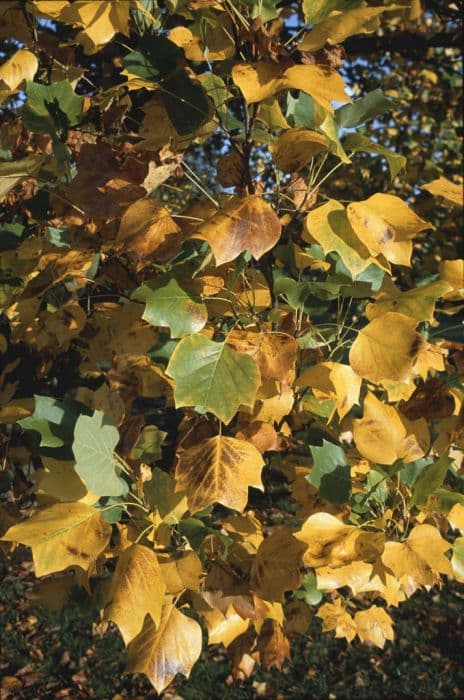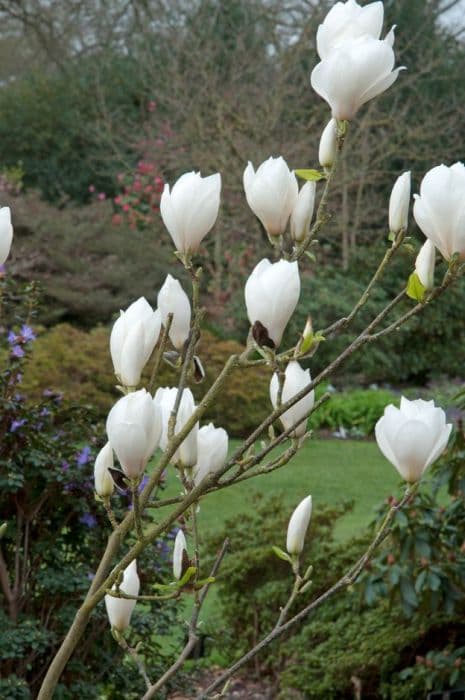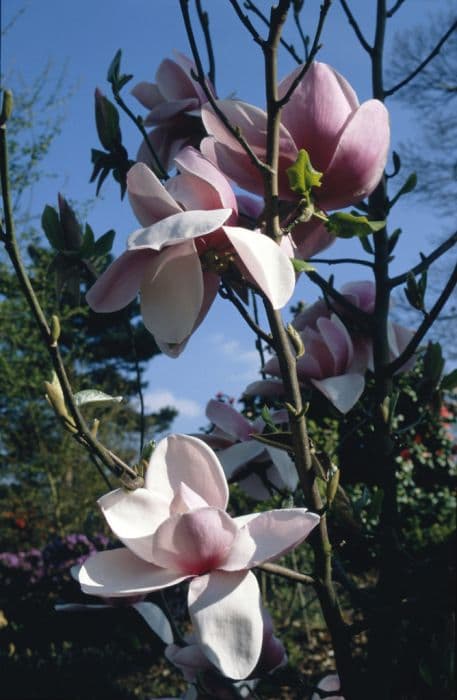Saucer Magnolia Magnolia × soulangeana

ABOUT
Magnolia × soulangeana, commonly known as saucer magnolia, is a striking ornamental plant well-loved for its impressive floral display. The saucer magnolia features large, cup-shaped flowers that bloom early in spring before the leaves fully emerge. These blossoms are typically a blend of pink and white, though some can be more solid in color ranging from deep magenta to pure white. Each flower can be quite substantial in size, making them a stunning visual highlight in any garden. The leaves of the saucer magnolia are broad and glossy, dark green in color, and provide a lush backdrop for the floral spectacle. As the flowering season concludes, the plant's foliage takes center stage, offering dense greenery throughout the summer months. In fall, the leaves may turn to a golden-brown shade, providing seasonal interest. The branching structure of the saucer magnolia typically gives it a rounded and spreading appearance. Its limbs are sturdy, and they arch gracefully under the weight of the large blooms and foliage. The bark is smooth and gray, providing a subtle but attractive contrast against the verdant leaves and colorful flowers. Saucer magnolia trees have an enduring appeal in landscapes, appreciated for their dramatic blooms and the elegance they lend to garden settings. Their appearance signals the transition from winter to spring and their widespread popularity owes much to their vibrant floral display and attractive form.
About this plant
 Names
NamesFamily
Magnoliaceae.
Synonyms
Saucer Magnolia, Tulip Magnolia, Chinese Magnolia, Japanese Magnolia.
Common names
Yulania soulangiana, Magnolia chinensis, Magnolia denudata var. soulangiana, Magnolia conspicua var. soulangiana, Magnolia soulangiana
 Toxicity
ToxicityTo humans
Saucer Magnolia is not known to be toxic to humans. There are no significant reports of poisoning or toxic reactions from ingesting this plant. As with any plant material, individual sensitivities can vary, and it's generally advisable to avoid eating ornamental plants.
To pets
Saucer Magnolia is also not known to be toxic to pets. There are no substantial reports of pets being poisoned by eating parts of this plant. However, it's always important to monitor pets around plants, as they may have individual reactions or could experience gastrointestinal upset from ingesting plant matter that they're not accustomed to.
 Characteristics
CharacteristicsLife cycle
Perennials
Foliage type
Deciduous
Color of leaves
Green
Flower color
Mixed
Height
15-20 feet (4.5-6 meters)
Spread
15-25 feet (4.5-7.6 meters)
Plant type
Tree
Hardiness zones
4-9
Native area
Cultivar
Benefits
 General Benefits
General Benefits- Aesthetic Appeal: Saucer magnolia boasts large, showy flowers that can add significant ornamental value to landscapes.
- Seasonal Interest: With its vivid spring blooms and attractive fall foliage, it offers multiple seasons of visual interest.
- Shade and Shelter: As it matures, its canopy provides shade and can be a refuge for birds and other wildlife.
- Low Maintenance: Saucer magnolia generally requires minimal pruning and maintenance once established.
- Tolerance of Soil Types: It can typically handle a variety of soil conditions, making it adaptable to different landscapes.
- Urban Tolerant: It is relatively tolerant of urban pollution, making it suitable for city planting.
 Medical Properties
Medical PropertiesThis plant is not used for medical purposes.
 Air-purifying Qualities
Air-purifying QualitiesThis plant is not specifically known for air purifying qualities.
 Other Uses
Other Uses- Magnolia × soulangeana, commonly known as Saucer Magnolia, can be used in woodworking to create fine furniture and veneer, taking advantage of its occasionally sturdy wood.
- The fibrous bark of the Saucer Magnolia may be used in making ropes and fabric-like materials in small-scale artisanal crafts.
- Saucer Magnolia buds can be used for botanical art as they provide an intricate and aesthetically pleasing subject for detailed illustrations.
- The dried leaves of the Saucer Magnolia can be used as a natural mulch in gardens, providing soil nourishment and weed suppression.
- Pressed flowers and leaves of the Saucer Magnolia serve as decorative elements in scrapbooking and papermaking for a natural touch.
- The Saucer Magnolia’s large, sturdy leaves can be used in floral arrangements as a backing material to provide structure and greenery.
- Captured rainwater from the broad leaves of the Saucer Magnolia can be collected for small scale irrigation in home gardens.
- The plant’s seed pods can be used in dried flower arrangements or as a component in potpourri mixes, due to their unique shape and texture.
- Saucer Magnolia petals can be crystallized and used as an edible decoration on desserts for a touch of elegance and a hint of floral flavor.
- The bark and branches of the Saucer Magnolia can be crafted into wreaths and other decorative items for rustic home decor aesthetics.
Interesting Facts
 Feng Shui
Feng ShuiThe Saucer Magnolia is not used in Feng Shui practice.
 Zodiac Sign Compitability
Zodiac Sign CompitabilityThe Saucer Magnolia is not used in astrology practice.
 Plant Symbolism
Plant Symbolism- Perseverance and Determination: Given its early bloom, often before the leaves, Magnolia × soulangeana symbolizes resilience and the ability to endure tough conditions.
- Feminine Beauty: The delicate and showy appearance of the saucer magnolia flowers is associated with grace, beauty, and gentleness, which are often seen as feminine qualities.
- Nobility: In ancient China, magnolias were thought to represent nobility and dignity, and this symbolism has persisted through time.
- Purity and Innocence: The pristine white of some varieties of saucer magnolia blooms is commonly associated with purity and innocence.
 Water
WaterSaucer Magnolia prefers evenly moist soil and should be watered deeply once a week, providing about 1 to 1.5 gallons of water for smaller trees and up to 3 gallons as the tree matures. During the growing season or hotter months, you may need to water twice a week if the weather is particularly dry or hot. Always check the soil moisture before watering; it should be moist but not soggy. Reduce watering during the dormant season, ensuring the tree doesn't sit in waterlogged soil to prevent root rot.
 Light
LightSaucer Magnolia thrives in full sun to partial shade. The ideal spot is where it can receive at least 4 to 6 hours of direct, unfiltered sunlight each day. A location that provides morning sunlight with some afternoon shade would be optimal to protect its blooms from late winter frosts.
 Temperature
TemperatureSaucer Magnolia is hardy and maintains health in a temperature range between 20 to 85 degrees Fahrenheit. It can withstand cold down to about 0 degrees Fahrenheit but is best protected from extreme winter winds. The ideal temperature conditions for the Saucer Magnolia are moderate, avoiding the extremes of either hot or freezing temperatures for prolonged periods.
 Pruning
PruningSaucer Magnolia requires limited pruning, primarily to maintain shape and remove dead or damaged branches. It is best to prune after blooming, in late spring or early summer, to avoid cutting off next year's flower buds. Young trees benefit from the selective removal of branches to establish a strong framework, while mature trees typically need less frequent pruning.
 Cleaning
CleaningAs needed
 Soil
SoilSaucer Magnolia requires well-draining, rich soil with high organic content. A mix of loam, peat moss, and compost is ideal. Soil pH should be slightly acidic to neutral, around 5.5 to 7.0.
 Repotting
RepottingSaucer Magnolias are typically not repotted as they are large shrubs or trees. Instead, they are planted in a suitable location where they can grow undisturbed for many years.
 Humidity & Misting
Humidity & MistingSaucer Magnolia thrives in average outdoor humidity levels; it does not require any special humidity adjustments when grown in its natural outdoor environment.
 Suitable locations
Suitable locationsIndoor
It's challenging; requires bright light, ample space.
Outdoor
Plant in well-draining soil with full sun to partial shade.
Hardiness zone
4-9 USDA
 Life cycle
Life cycleSaucer magnolia (Magnolia × soulangeana) begins its life cycle with seed germination, which occurs in a moist, well-drained soil environment. The seedling stage follows germination, where the young plant establishes roots and sprouts its first leaves. As the plant enters the vegetative stage, it develops a woody stem, more leaves, and begins to form the characteristic structure of a magnolia tree. Flowering is a critical stage in the saucer magnolia's life cycle, with the tree producing large, fragrant blossoms that are pink, white, or purple, typically in early spring before the leaves emerge. After pollination, which is often facilitated by bees, the flowers develop into cone-like fruit that releases red seeds when mature. Finally, the plant reaches maturity, where it can continue to grow and reproduce for many years, completing the cycle when it eventually senesces and dies.
 Propogation
PropogationPropogation time
Spring-Early Summer
Propogation: The Saucer Magnolia (Magnolia × soulangeana) is often propagated by cuttings, a popular method that aims to clone the parent plant. The best time to take cuttings for propagation is in late spring or early summer when the plant's growth is most vigorous. A cutting should be from a healthy branch, about 4 to 6 inches long (10 to 15 centimeters), and should include at least two sets of leaf nodes. The bottom cut should be made just below a set of leaf nodes, and the leaves on the lower half of the cutting should be removed. To encourage root growth, the base of the cutting can be treated with a rooting hormone powder or gel. The cutting is then planted in a well-draining potting mix, ensuring that at least one set of leaf nodes is below the surface of the soil. The pot should be kept in a warm, humid environment until the cutting has rooted, which can be checked by a gentle tug after a few weeks to see if there is resistance.








![Magnolia [Felix Jury]](/_next/image?url=https%3A%2F%2Fplants-admin.emdemapps.com%2Fimages%2Fplants%2F%2Fimages%2F604b61a0b23b7.png&w=640&q=75)
